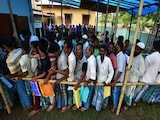When the world first heard the word "coronavirus" in late 2019, few imagined that the virus would continue to reinvent itself half a decade later. From the devastating Delta wave in India to Omicron's explosive global spread, each new variant has altered the trajectory of the pandemic, forcing scientists to re-evaluate vaccines, treatments, and public health strategies. Today, while the panic of 2020-21 has eased, COVID-19 hasn't gone away. Instead, it has settled into a pattern of constant evolution, spawning sublineages with names that sound almost meteorological, Nimbus and Stratus, now being closely watched by global health agencies.
Understanding where these variants came from, how they differ, and which ones still pose a genuine threat is essential not only for policymakers and doctors, but also for every Indian trying to gauge their own risk.
Viruses mutate. That's biology. Most changes are irrelevant, but some alter transmissibility, immune escape, or disease severity. Tracking those COVID variants tells clinicians and policy makers whether vaccines need updating, whether therapies will still work, and who should get priority boosters. The World Health Organization (WHO) and regional bodies maintain rolling lists so scientists can focus on lineages that merit attention.
A Chronological Tour Of The Main COVID Variants
Below are the major COVID variants and notable later sublineages in the order they first came to attention (as per the WHO), with short notes on how each differed, its global and India impact, key symptoms, treatments and whether it's considered a current threat.
1. The original (Wuhan) strain: Late 2019
What made it notable: The first recognized SARS-CoV-2 virus.
Impact: Sparked global pandemic; severe waves before vaccines. India: the very first cases and the beginning of public-health response.
Symptoms/treatment: Classic COVID symptoms (fever, cough, breathlessness); treatments were supportive plus later use of dexamethasone for severe disease.
Current threat level: Replaced long ago by later variants.
2. Alpha (B.1.1.7): Detected Sept-Dec 2020 (UK)
Different because: Mutations increased transmissibility vs ancestral strain.
Global/India impact: Drove early 2021 waves in many countries; less dominant in India than Delta.
Symptoms/treatment: Similar clinical picture; standard therapeutics and vaccines still largely effective against severe disease.
3. Beta (B.1.351): Late 2020 (South Africa)
Different because: Spike mutations that reduced neutralization by some antibodies.
Impact: Concern over vaccine escape prompted renewed study; limited large-scale dominance globally compared with Alpha/Delta. India saw sporadic detections, but no waves to set alarm bells ringing.
4. Gamma (P.1): Late 2020 (Brazil)
Different because: Mutations linked to reinfection in places with prior waves.
Impact: Major regional effect in South America; limited prolonged dominance in India.
5. Delta (B.1.617.2): First recognized in India (Oct 2020); Global impact (2021)
Different because: Markedly higher transmissibility and higher risk of hospitalisation than earlier variants.
Impact: The devastating India wave in spring 2021 was driven by Delta; it reshaped global pandemic policy in 2021. Vaccines remained protective against severe disease but breakthrough infections rose.
Symptoms/treatment: Broader clinical severity; dexamethasone, oxygen support, antivirals and monoclonal antibodies (some retained efficacy).
Current threat: Largely superseded by Omicron and its descendants.
6. Omicron (B.1.1.529): Nov 2021 (South Africa) and its many descendants
Different because: A very large number of spike mutations producing major immune escape and extremely rapid spread.
Impact: Global surge in late 2021-2022 with many sublineages (BA.1, BA.2, BA.5, XBB and more). Severe disease concentrated in the elderly/immunocompromised; vaccines (including updated boosters) continued to protect against severe outcomes. In India, Omicron produced high caseloads but comparatively lower death rates than Delta waves, largely due to immunity from prior infections and vaccinations.
Symptoms/treatment: Tended toward upper-airway symptoms in many cases (sore throat, runny nose); antivirals (nirmatrelvir/ritonavir, remdesivir) and updated vaccines remain the backbone of treatment/prevention.
Current threat: Omicron lineage and descendants remain the dominant family, but individual sublineages wane and new ones appear.
7. The newer sublineages: Nimbus (NB.1.8.1) and Stratus (XFG), 2024-2025
Different because: These are Omicron descendant sublineages with additional spike changes that can increase transmission and modestly reduce neutralization by prior immunity. Public health agencies like the European Centre For Disease Control and Prevention (ECDC) classify them as Variants Under Monitoring (VUMs) while evaluating their public-health implications.
Global/India impact: Nimbus and Stratus have driven recent case rises in several countries (reports in mid-2025 note rapid spread in the UK and other regions). As of the latest surveillance updates WHO and regional agencies are watching them for increased spread and immune escape but have not-so far-found clear evidence of higher clinical severity compared with prior Omicron sublineages. India has reported detections through routine surveillance but large, severe waves have not been universally observed yet.
Symptoms/treatment: Clinical pictures remain similar to Omicron: sore throat (notably sharp "razor-blade" sore throat reported anecdotally with some sublineages), cough, runny nose, fatigue; severe disease still concentrated among the unvaccinated, elderly and immunocompromised. Approved antivirals and up-to-date vaccines are the primary defenses.
Which COVID Variants Are Threats Right Now
The family of Omicron descendants (including XFG/Stratus and NB.1.8.1/Nimbus) is currently the driver of cases globally. Agencies list a small set of VUMs to watch closely. None, at the latest reporting, showed clear, consistent evidence of higher severity than previous Omicron lineages, but their combination of immune escape and transmissibility can still stress health systems if case numbers surge. Continued surveillance, booster campaigns for at-risk groups, and availability of antivirals are the appropriate public-health responses.
SARS-CoV-2 continues to evolve. For most healthy, vaccinated adults the risk of severe disease remains lower than during the Delta era, but older people and immunocompromised individuals should remain cautious. Public-health surveillance in India and the world is active, and scientists will flag any variant that meaningfully changes risk.
Disclaimer: This content including advice provides generic information only. It is in no way a substitute for a qualified medical opinion. Always consult a specialist or your own doctor for more information. NDTV does not claim responsibility for this information.















